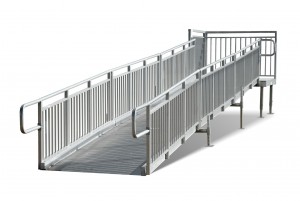As wheelchair ramps become more common in public spaces, it’s essential to ensure they are convenient for users and safe. In hospitals where patients and visitors may already deal with health issues or mobility limitations, wheelchair ramps must be equipped with excellent user safety features. Fortunately, REDD Team designs and manufactures quality hospital access products, including wheelchair ramps with many safety and usability features.
Slip-Resistant Surface
 The slip-resistant surface is one of the most critical user safety features of wheelchair ramps. Since hospital ramps are likely to be used by patients and visitors who may already have difficulty with balance or coordination, a slip-resistant surface helps to prevent accidents by providing additional grip for wheelchairs. REDD Team wheelchair ramps feature textured surfaces to enhance traction and prevent slips and falls.
The slip-resistant surface is one of the most critical user safety features of wheelchair ramps. Since hospital ramps are likely to be used by patients and visitors who may already have difficulty with balance or coordination, a slip-resistant surface helps to prevent accidents by providing additional grip for wheelchairs. REDD Team wheelchair ramps feature textured surfaces to enhance traction and prevent slips and falls.
Sturdy Handrails
Handrails are another critical safety feature for wheelchair ramps in hospitals. They provide support and stability for users as they navigate the ramp. REDD Team wheelchair ramps are made of strong and durable aluminum, making them excellent choices for facilitating access in hospitals and other facilities.
Proper Width
The width of the ramp is an important safety feature to consider when it comes to the safety of patients in your hospital environment. For wheelchair users to navigate the ramp safely, it should be wide enough to accommodate the wheelchair and any necessary accessories, such as oxygen tanks or IV poles. The Americans with Disabilities Act (ADA) specifies that wheelchair ramps in public spaces should be at least 36 inches wide. Still, hospitals may need wider ramps to accommodate larger medical equipment.
Slope
ADA recommends that wheelchair ramps have a slope of no more than 1:12 (i.e., for every inch of rise, there should be 12 inches of ramp length). Steeper ramps can be difficult for wheelchair users to navigate safely, increasing the risk of accidents or falls. In addition, ramps with a slope greater than 1:20 may require handrails on both sides of the ramp. REDD Team wheelchair ramps are compliant with state regulations and building codes. When you buy our wheelchair ramps, you can know that your access products are safe for users and your building is compliant.
Adequate Lighting
Lighting is critical in hospital mobility, especially in poorly lit areas or low visibility. Adequate lighting helps to ensure that users can see the ramps and any potential hazards, such as changes in elevation or uneven surfaces. Lighting should illuminate the entire ramp and be positioned not to create glare or shadows that could confuse users.
Capacity
The number of people a wheelchair ramp can hold determines user safety. REDD Team hospital wheelchair ramps have high load capacities meaning they can support the weight of the wheelchair user as well as any necessary medical equipment or accessories. The weight capacity of the ramp is marked and checked regularly to ensure that it is still safe to use.
Consider multiple factors when shopping for wheelchair ramps for your hospital, including weight capacities and compliance. Be sure to install wheelchair ramps that comply with your state’s building codes. AT REDD Team, our technicians are familiar with states’ building codes and regulations, so all our access products are ADA, OSHA, and IBC compliant. In addition, we can customize your access ramp to meet your building’s access needs without compromising compliance.
Please get in touch with REDD Team today for quality wheelchair ramps for hospitals.

